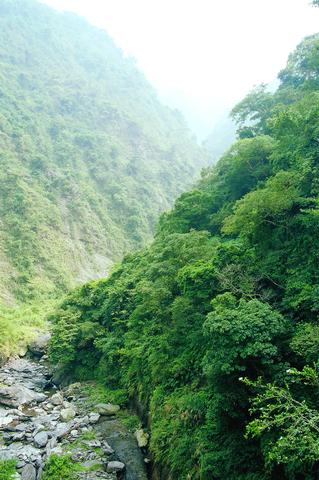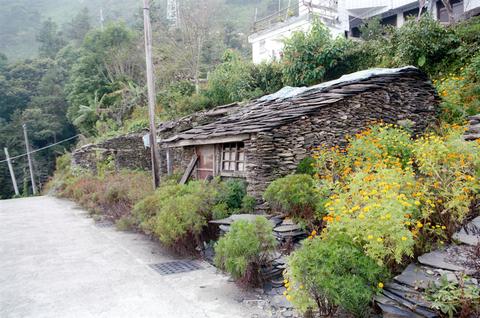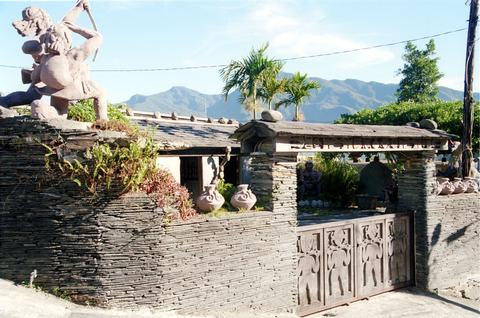Sitting at the police checkpoint at Sante (
"What's your business inside?" he asked distractedly of one driver who stopped outside the concertina gate, where the road narrowed to a single lane.
"Just here to look around," was the reply.

PHOTO: IAN BARTHOLOMEW
"Can't go in then," said the policeman. "You have to know somebody inside."
The driver hesitated a moment, but thinking of nothing to say, retreated to his car and turned back.
Other traffic passed through with a wave of the hand or a toot of the horn -- local people who the constable knew well.

PHOTO: IAN BARTHOLOMEW
"If they know somebody, then they can go in. But we can't keep track of them once they're inside," said a plainclothes officer in charge of the station, who was busy brewing tea. "Mostly they come to enjoy the mountain scenery and the streams."
Culture conflict
The Aboriginal village of Wutai is the largest town located on this section of Provincial Highway 24 beyond the Sante checkpoint. Despite restrictions on entry, Wutai is known as a tourist destination where city people can come and enjoy the mountain air. To accommodate these visitors, many locals have converted a section of their homes into guestrooms, where "homestays" are offered for a small fee and visitors can enjoy many of the comforts of home.

PHOTO:IAN BARTHOLOMEW
"There aren't many hotels around here," said Hsieh Cheng-chuan (
With its polished wooden floor, Japanese-style sleeping platforms, fridge and television, it offered considerably more luxury than could be obtained at a city hotel for double the price.We were sitting on the large veranda sipping tea and ginger, enjoying the cool evening. The only sound was of some town elders chatting down in the courtyard of the nearby cultural center. "When we have groups up, they can sit here and barbecue," Hsieh said.
Restrictions on entry have kept numbers limited, but groups of three and above can apply for entry permits from the Pingtung County Police (

PHOTO: IAN BARTHOLOMEW
The silence of the evening was rudely broken by the arrival of a hunting party on motorbikes. They were joined by a man in dirty green flannelette considerably the worse for drink. As I sat there, a number of arguments seemed to break out at the same time. The rustic idyll that I had been building in my mind moments ago rapidly dissolved.
"I don't know if the restrictions [on entry] are good or bad," Hsieh's husband said. "If too many tourists come in, the town will change.
"Working here there is little pressure," he added, casually hugging his two noisy children as he looked up into the dark night. "But there are very few jobs available here. Most people have gone down to the plains to work."
This was a refrain I was to hear from many people I spoke to in the mountains.
At one point the drunk turned to me and demanded. "Who brought you here? You must register with the police. You are not permitted to be here."
My hosts, possibly glad of a little extra money, showed no inclination to enforce any form of registration, and the drunk contented himself with sullen antipathy.
This was not the only time that locals had expressed surprise at my presence -- only the most unpleasant one. Such occasions were a sharp reminder of the complex response that tourism inspires in many Aboriginal inhabitants of Taiwan's mountain regions.
According to Lin Huang-ming (
Further in from Wutai, at the very extremity of Provincial Highway 24, is the town of Ali. From here there are a few concrete paved roads leading up to a few isolated houses, but there is little else. The streets are all but deserted.
Standing in the small parking area outside the empty police station, Tang Huei-tse (
"Our ancestors have lived here for thousands of years," Tang said. "Most of the old people who remain haven't the strength for farming." They rely mostly on money sent back by the young people in the plains.
There was something infinitely sad about this genial man in this quiet unregarded town, known mainly to hikers as one of the starting points for the four-hour trip to Devil Lake (
Despite its remoteness, few of the houses are built from slate sheets, the traditional building material of the Rukai Aborigines. This material has been almost completely replaced by concrete and steel siding. The few stone houses that remain were largely derelict.
"I guess those stone houses are representative of the spirit of the [Aboriginal] people," the police officer at the checkpoint had said to me dismissively.
"Our main concern is to prevent illegal quarrying of slate," he added. "That is why this station is manned 24-hours a day." Tourists are apt to pick up a few slabs of slate, or even some of the art works that are left outside houses. "But it's impossible to police," he added with a shrug.
But for Oubaku (
"They are there to restrict our activities," he said. As a carver of images on slate, regulations against the export of slate from the reservation hampers his ability to market his work. "The only good thing about living here is that the air is fresh. So I can smoke more cigarettes," he said, lighting up.
Many of the Aborigines I met along this tail end of Provincial Highway 24 acknowledged the existence of various regulations governing their lives in the protected area. At the same time, they were all too ready to admit that they paid little attention to them.
"Of course we go hunting. For some, it is the only way of getting by," said a laborer helping Oubaku. "Anyway, it's a natural check on animal numbers. We don't want any of the animals dying of old age."
At a restaurant down the road, I was offered a bowl of fish soup. "These fish are national treasures. Protected. Taste good don't they." This from the dapper middle-aged lady proprietor presiding over a table of four people drinking rice wine. It was a kindly gathering, but one of the party was clearly drunk and offered incoherent memories of the better life under Japanese rule.
Unfinished business
Apart from untended trails such as the one to Devil Lake and the scenery along the road, there are few facilities for tourists. Information boards along the road suggest that the homestay project was larger in conception than in execution. "The only towns with homestays are Wutai and Shenshan (
There are many other signs of abandoned development along Provincial Highway 24. Above Wutai, a paved trail with the green and yellow concrete railings that seem to be a signature of government sponsored tourist trails around the island, led enticingly into the hills. A printed sign pointed to a rest area (overgrown), toilets (locked) and a lookout.
The paving was already much broken. Vegetable gardens showed signs of advanced neglect. And in a cage by the path, a dog, dead from starvation, his head pushed pitifully between gnawed bars, was, for me, a definitive sign of the callous indifference with which this and other projects seemed to have been picked up and then dropped when the money ran out.
In their reservation, protected by the police checkpoint, I wondered if the Aborigines faced a similar fate.
Entry to Wutai is through the town of Santimen (
Shenshan Mountain Villa (
Hsieh Cheng-chuan of the Shanfeng Restaurant (山豐餐店), one of numerous homestay options in Wutai, can be contacted at (08) 790-2261.

As I finally slid into the warm embrace of the hot, clifftop pool, it was a serene moment of reflection. The sound of the river reflected off the cave walls, the white of our camping lights reflected off the dark, shimmering surface of the water, and I reflected on how fortunate I was to be here. After all, the beautiful walk through narrow canyons that had brought us here had been inaccessible for five years — and will be again soon. The day had started at the Huisun Forest Area (惠蓀林場), at the end of Nantou County Route 80, north and east

Specialty sandwiches loaded with the contents of an entire charcuterie board, overflowing with sauces, creams and all manner of creative add-ons, is perhaps one of the biggest global food trends of this year. From London to New York, lines form down the block for mortadella, burrata, pistachio and more stuffed between slices of fresh sourdough, rye or focaccia. To try the trend in Taipei, Munchies Mafia is for sure the spot — could this be the best sandwich in town? Carlos from Spain and Sergio from Mexico opened this spot just seven months ago. The two met working in the

Exceptions to the rule are sometimes revealing. For a brief few years, there was an emerging ideological split between the Democratic Progressive Party (DPP) and Chinese Nationalist Party (KMT) that appeared to be pushing the DPP in a direction that would be considered more liberal, and the KMT more conservative. In the previous column, “The KMT-DPP’s bureaucrat-led developmental state” (Dec. 11, page 12), we examined how Taiwan’s democratic system developed, and how both the two main parties largely accepted a similar consensus on how Taiwan should be run domestically and did not split along the left-right lines more familiar in

A six-episode, behind-the-scenes Disney+ docuseries about Taylor Swift’s Eras Tour and Rian Johnson’s third Knives Out movie, Wake Up Dead Man, are some of the new television, films, music and games headed to a device near you. Also among the streaming offerings worth your time this week: Chip and Joanna Gaines take on a big job revamping a small home in the mountains of Colorado, video gamers can skateboard through hell in Sam Eng’s Skate Story and Rob Reiner gets the band back together for Spinal Tap II: The End Continues. MOVIES ■ Rian Johnson’s third Knives Out movie, Wake Up Dead Man